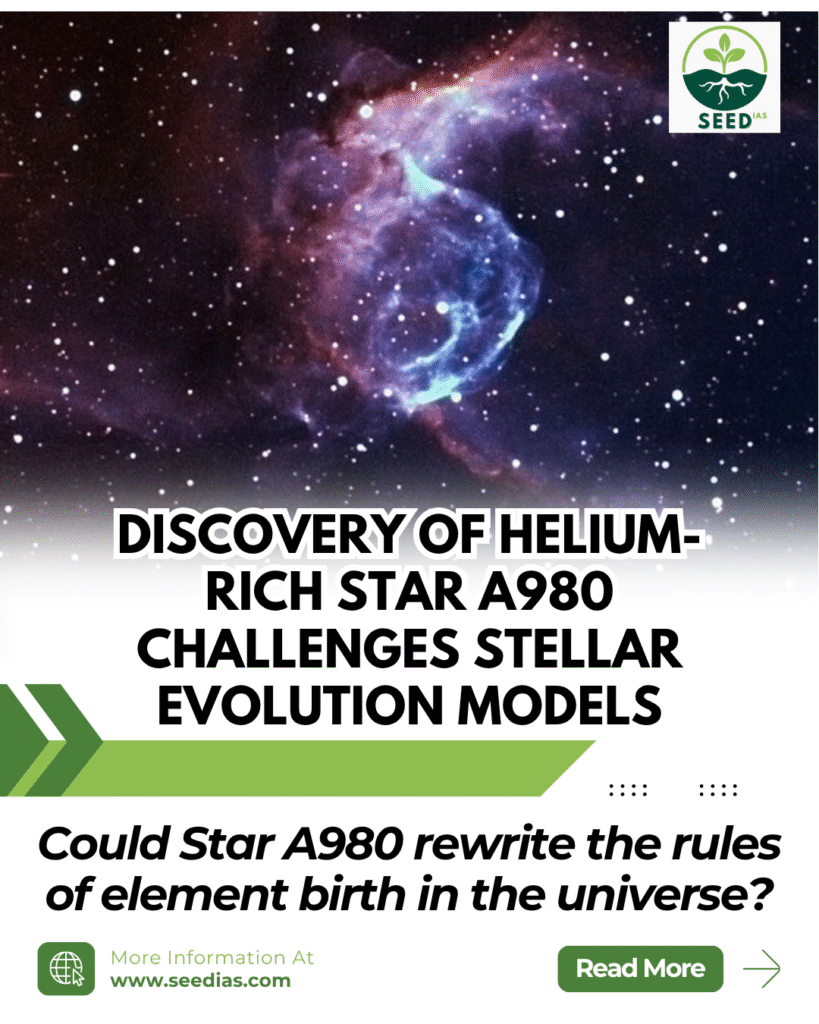Why in NEWS
Scientists at the Indian Institute of Astrophysics (IIA), Bengaluru, discovered a rare helium-rich star named A980, exhibiting unprecedented germanium levels. This finding contradicts existing stellar evolution theories and opens new avenues in astrophysics research.
Key Terms / Concepts
| Term | Explanation |
|---|---|
| Extreme Helium (EHe) Star | A rare type of evolved star made almost entirely of helium with negligible hydrogen. |
| Singly-ionized Germanium (Ge II) | A form of germanium where one electron is removed; rarely observed in stellar atmospheres. |
| Stellar Nucleosynthesis | The process by which elements are formed within stars through nuclear fusion. |
| White Dwarf Merger | A phenomenon where two white dwarfs collide or merge, potentially triggering unique stellar events. |
Key Facts about Star A980
| Feature | Details |
|---|---|
| Location | Ophiuchus constellation, ~25,800 light years away from Earth. |
| Type | Cool Extreme Helium (EHe) star. |
| Discovery | First-ever detection of singly-ionized germanium (Ge II) in an EHe star. |
| Composition | Germanium level is 8× higher than in the Sun. |
| Significance | Challenges the conventional theory that heavy elements like germanium are formed only in supernovae or AGB stars. |
Why is this Discovery Important?
| Aspect | Significance |
|---|---|
| Stellar Evolution | Existing models do not account for such heavy element synthesis in EHe stars. |
| Merger Theory | Suggests element formation could occur during white dwarf mergers, not just in supernovae. |
| Astrophysics Research | Demands a revision of stellar nucleosynthesis and evolution models to include post-merger scenarios. |
About Indian Institute of Astrophysics (IIA)
| Aspect | Description |
|---|---|
| Type | Autonomous research institution under the Department of Science & Technology (DST). |
| Founded | Traces back to Madras Observatory (1786), moved to Kodaikanal (1899), renamed IIA in 1971. |
| HQ | Bengaluru (since 1975). |
| Focus | Astronomy, astrophysics, and engineering sciences related to space research. |
In a nutshell
Mnemonic: A980
“A” Rare,
“9”x Germanium,
“8”x Solar,
“0” Hydrogen
Star A980’s unique chemical fingerprint could rewrite what we know about elemental birthplaces in the cosmos, especially in post-merger stellar events.
Prelims Practice Questions
- What makes the star A980 discovered by Indian scientists unique?
A. It is the first star discovered beyond the Milky Way
B. It is the first star to show helium fusion
C. It shows exceptionally high levels of germanium
D. It is composed entirely of hydrogen - Extreme Helium (EHe) stars are generally formed due to:
A. Nuclear fission of iron-rich stars
B. Supernova explosions of neutron stars
C. Merger of helium-rich and carbon-oxygen white dwarfs
D. Collapse of black holes - Which of the following statements is correct about germanium detection in A980?
A. Germanium was detected in triple-ionized form
B. It is usually found in all hydrogen-rich stars
C. Its levels are eight times lower than in the Sun
D. It was detected in singly-ionized form (Ge II)
Mains Practice Questions
- What are Extreme Helium stars? Discuss how recent discoveries like A980 challenge conventional models of stellar evolution. (GS 3 – Science & Technology)
- Explain the significance of white dwarf mergers in light of recent observations of unusual chemical compositions in evolved stars. (GS 3 – Space Science)
Prelims Answers with Explanations
| Q.No | Answer | Explanation |
|---|---|---|
| 1 | C | A980 shows eight times more germanium than the Sun. |
| 2 | C | EHe stars typically result from white dwarf mergers. |
| 3 | D | The star A980 revealed the presence of singly-ionized germanium (Ge II). |
















